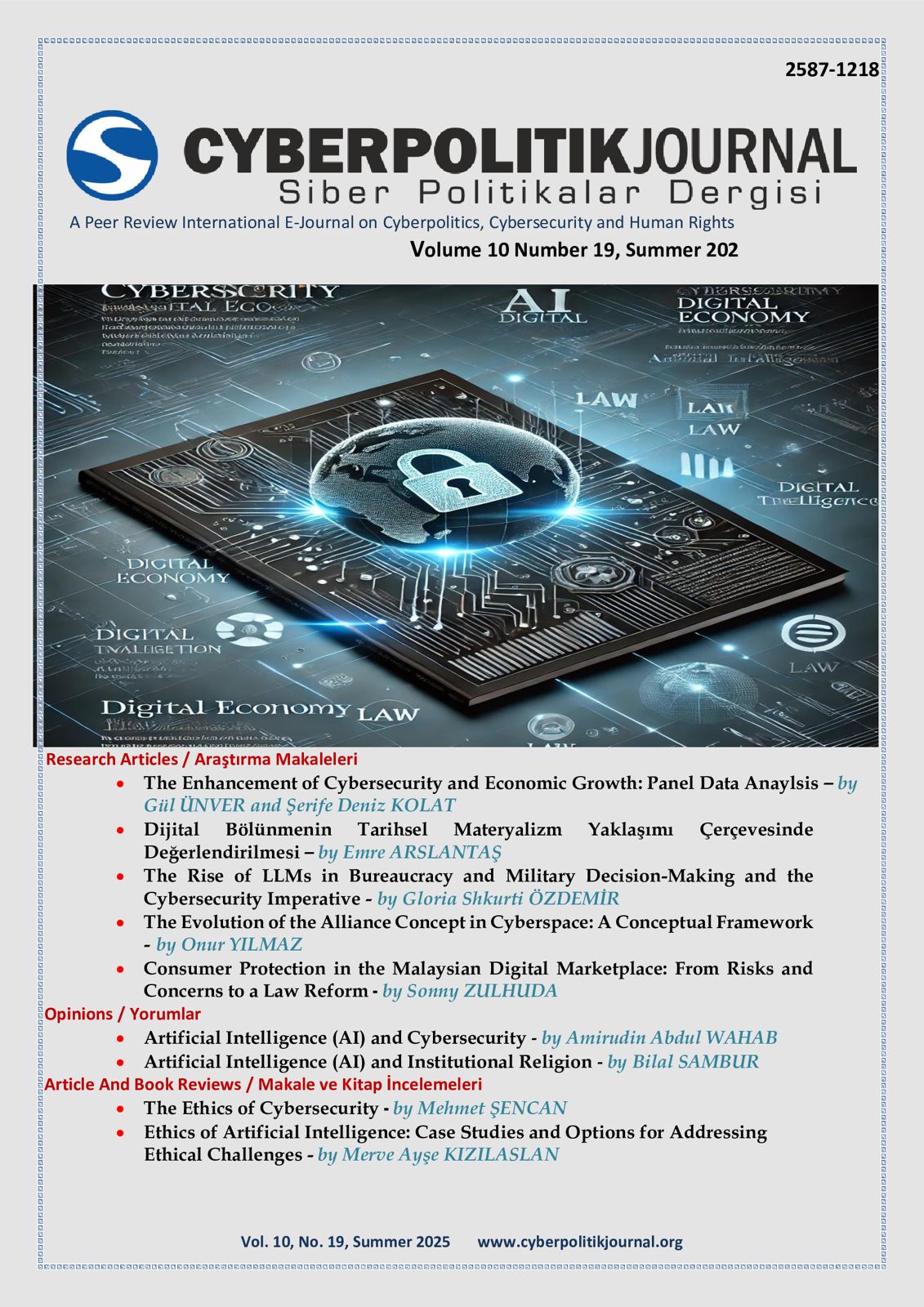THE EVOLUTION OF THE ALLIANCE CONCEPT IN CYBERSPACE: A CONCEPTUAL REVIEW
Keywords:
Cyberspace, Cyber Alliances, Cybersecurity, International RelationsAbstract
The classical realist approach considers the multi-actor, borderless, and hyper-anarchic nature of cyberspace. Supported by a qualitative literature review, the analysis shows that states cannot alone deter and neutralize cyber threats; therefore, flexible cooperation mechanisms involving the public sector, private companies, and international organizations have become essential. The key to enabling such cooperation is developing a new and broader definition of alliance that goes beyond traditional security theories. In this context, the study aims to contribute to the literature by examining the concept of cyber alliance and its characteristics, which cannot be explained through classical security paradigms.
References
Akyeşilmen, N. (2017). Cyberspace as hyper-anarchy: A critical analysis. Journal of Cyber Policy, 2(1), 1-18.
Afsar, Ö. A. (2022). The Evolution of NATO’s Cybersecurity Policy. Cyberpolitik Journal, 7(13), 77-96.
Arshid, I., Irfan, H., & Tanveer, A. (2017). Alliances in international politics: A comparative study of Kenneth Waltz’s and Stephen Walt’s theories of alliances. Kaav International Journal of Arts, Humanities and Social Science, 4(3/A9), 44-51.
Benkő, G., Biczók, G. (2024). The cyber alliance game: How alliances influence cyber-warfare. arXiv, 2410(05953), 1–18.
Cains, M. G., Liberty, F., Taber, D., King, Z., & Henshel, D. S. (2022). Defining cybersecurity and cybersecurity risk within a multidisciplinary context using expert elicitation. Risk Analysis, 42(8), 1643–1669.
Council of Europe. (2001). Convention on Cybercrime. Strasbourg, France: Council of Europe. https://www.coe.int/en/web/cybercrime/the-budapest-convention.
Deibert, R. J., & Rohozinski, R. (2008). Cyberspace as hyper-anarchy: Towards a new research agenda. In R. J. Deibert & R. Rohozinski (Eds.), Access controls and digital governance in the global information age (pp. 431–454). Toronto: University of Toronto Press.
Eckstein, A. M. (2023). ‘Jackal bandwagoning’? The Achaean League shifts alliances from Macedon to Rome, autumn 198 B.C. The International History Review, 45(1), 1–11.
Eichensehr, K. (2017). Public-private cybersecurity. SSRN Electronic Journal, 467-505.
Erendor, M. E. (2016). Cyberterrorism within the framework of risk society and reflexive modernization: The problem of definition and typology. Cyberpolitik Journal, 1(1), 114–133.
Hare, F. (2021). Cybersecurity and cyber warfare: What everyone needs to know. Journal of Cyber Policy, 6(2), 123–145.
Khraisat, A., & Alazab, A. (2021). A critical review of intrusion detection systems in the Internet of Things: Techniques, deployment strategy, validation strategy, attacks, public datasets and challenges. Cybersecurity, 4(1), 1–27.
Li, J., Zhao, B., & Zhang, C. (2020). Fuzzing: A survey. Cybersecurity, 3(1), 1–41.
Libicki, M. C. (2019). Baltic-area cyberspace alliance. In T. Minárik, R. Jakschis, & L. Lindström (Eds.), 11th International Conference on Cyber Conflict: Silent Battle (pp. 201–212). Tallinn: NATO Cooperative Cyber Defence Centre of Excellence.
Mao, R. (2023). Coalitions in international relations and coordination of agricultural trade policies. China Agricultural Economic Review, 15(2), 433–437.
Mayer, M. (2015). Cyberspace and international politics (pp. 6–9). https://doi.org/10.13140/RG.2.1.4470.0886.
Mearsheimer, J. J. (2001). The tragedy of great power politics. New York, NY: W. W. Norton & Company.
Morgenthau, H. J. (1948). Politics among nations: The struggle for power and peace (4th ed., pp. 203-204). New York, NY: Alfred A. Knopf.
Morgenthau, H. J. (1954). Politics among nations: The struggle for power and peace (2nd ed., rev. & enl., pp. 131-133). Knopf.
Morgenthau, H. J. (1960). Politics among nations: The struggle for power and peace (3rd ed., pp. 137–138). New York, NY: Alfred A. Knopf.
NATO Cooperative Cyber Defence Centre of Excellence. (2023). The NATO CCDCOE welcomes new members: Iceland, Ireland, Japan and Ukraine. NATO CCDCOE News Bulletin, 2023(March), 1–2.
Russett, B. M. (1971). An empirical typology of international military alliances. American Journal of Political Science, 15(2), 263–281.
Saka, B., & Abdullahi, M. (2021). Alliance and coalition in contemporary international relations: The case of US-South Korea. Zamfara Journal of Politics and Development, 2(2), 1–3.
Schweller, R. L. (1994). Bandwagoning for profit: Bringing the revisionist state back in. International Security, 19(1), 72–107.
Siddiqi, F. (2016). Security Estimations in South Asia: Alliance Formation or Balance of Power. Strategic Studies, 36(2), 77–83.
Tarhan, K. (2022). Historical development of cybersecurity studies: A literature review and its place in security studies. Przeglad Strategiczny, 12(15), 393-414.
Waltz, K. N. (1979). Theory of international politics (pp. 126–127). Reading, MA: Addison-Wesley.
Winger, G. H. (2022). Cybersecurity in the U.S.-Philippine alliance: Mission seep. The Pacific Review. Advance online publication.
Yalçın, H. B. (2014). İttifaklar. In Ş. Kardaş & A. Balcı (Eds.), Uluslararası ilişkilere giriş: Tarih, teori, kavram ve konular (pp. 399–401). İstanbul: Küre Yayınları.
Yilmaz, O. (2020). Change of security paradigm; manifestation of the US and Russia competition in the cyber domain (Master’s thesis, Kocaeli University, Institute of Social Sciences, Department of International Relations).
Downloads
Published
How to Cite
Issue
Section
License

This work is licensed under a Creative Commons Attribution-NonCommercial-ShareAlike 4.0 International License.









